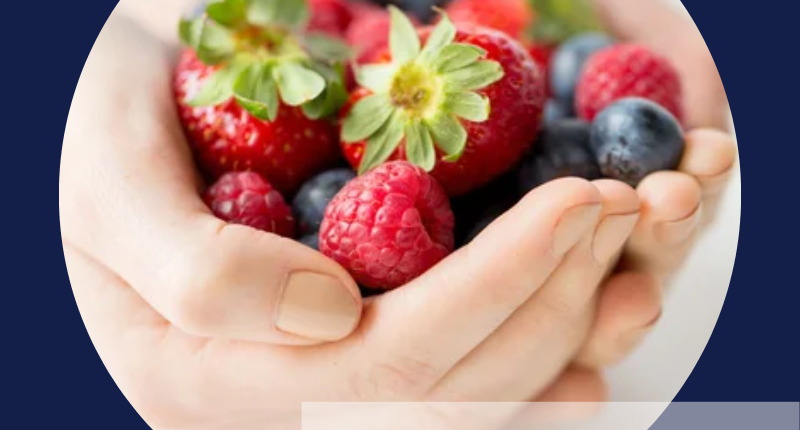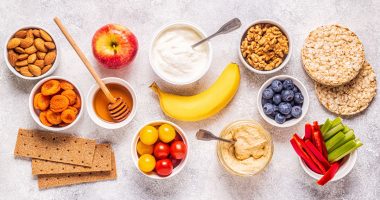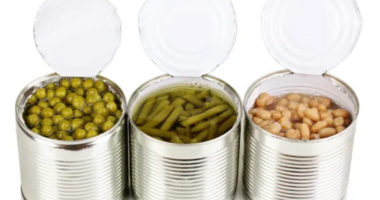Find out the “27 foods you can eat without gaining weight” Maintaining a healthy weight is about more than just avoiding certain foods. It’s about filling your plate with nutrient-rich options that keep you feeling satisfied and energized. The good news is, that there are plenty of delicious and healthy foods you can enjoy without gaining weight or tipping the scales.
In this article, Sound Health and Lasting Wealth will explore 27 fantastic foods that can be part of a balanced diet for weight management. From fruits and vegetables to lean proteins and whole grains, these options are packed with flavor and essential nutrients that will nourish your body and support your weight loss goals.
1. Celery
The first food on the list of the 27 foods you can eat without gaining weight is celery, a low-calorie, nutrient-dense food. One cup of chopped celery contains only 16 calories, making it a great option for those trying to lose weight. Celery is rich in fiber, which helps you feel fuller longer and improves digestion. This food is almost 95% water, which helps keep you hydrated and full. Celery contains potassium, folate, fiber, and 30% of your daily requirement of vitamin K. Celery can be eaten raw, cooked, or used in various dishes, such as salads, smoothies, or as a snack with hummus or peanut butter. Including celery in your diet can support your weight loss efforts by providing a satisfying, low-calorie snack option that can help you feel full and satisfied.
2. Lettuce
Lettuce is a leafy green vegetable that can be eaten without gaining weight. It is a low-calorie vegetable that is almost exclusively eaten raw. Lettuce is a cool-season crop that prefers temperatures of 55 to 65 °F for optimum growth. There are four main types of lettuce: romaine (or cos), crisphead, butterhead, and looseleaf. Within these four varieties, there are more than enough subvarieties to try a new one every day of the month. Lettuce is generally a rich source of vitamins K and A, though the nutritional quality varies depending on the variety. Lettuce is mostly made up of water, but it has significant health benefits. You can eat lettuce fresh or add it to salads, sandwiches, burgers, wraps, tacos, and more to add more volume to your meals without adding calories. Lettuce is a nutrient-dense snack option that deserves a place in any weight loss diet plan.
3. Watermelon
Watermelon is a low-calorie fruit that can be eaten without gaining weight. It is around 90% water and provides electrolytes, such as potassium, making it a healthful choice of snack during the hot summer months. Watermelon is a sweet, commonly consumed fruit of summer, usually as fresh slices, diced in mixed fruit salads, or as juice. Watermelon juice can be blended with other fruit juices or made into wine. Watermelon is also a nutrient-dense food that contains various essential nutrients, including vitamins A and C, potassium, magnesium, and dietary fiber. Watermelon contains higher levels of lycopene than any other fresh fruit or vegetable, making it part of a healthy diet. You can eat watermelon fresh, as juice, or frozen in slices for a tasty cold Popsicle-style snack.
4. Broccoli
Broccoli is a low-calorie vegetable that can be eaten without gaining weight. It is a cruciferous vegetable that is rich in antioxidants and other beneficial plant compounds. Broccoli is high in many nutrients, including fiber, vitamin C, vitamin K, iron, and potassium. It is also a particularly rich source of vitamin C and vitamin K. Broccoli contains sulfur-containing glucosinolate compounds, isothiocyanates, and sulforaphane, which are diminished by boiling but are better preserved by steaming, microwaving, or stir-frying. Broccoli may offer several benefits, especially for eye health, heart health, and disease prevention. You can eat broccoli raw or cooked, and it can be added to salads, soups, stir-fries, casseroles, and more. Roasting broccoli with garlic, lemon, and Parmesan cheese is a delicious way to enjoy this vegetable.
5. Cauliflower
Cauliflower is a low-calorie vegetable that is rich in antioxidants and other beneficial plant compounds. Cauliflower is high in many nutrients, including fiber, vitamin C, vitamin K, iron, and potassium. It is also a particularly rich source of vitamin C and vitamin K. Cauliflower is a versatile vegetable that can be consumed raw or cooked in a variety of ways, such as steaming, roasting, or sautéing. It makes an excellent side dish or can be combined with dishes like soups, salads, stir-fries, and casseroles. Cauliflower is also a gluten-free alternative to rice and flour. You can make cauliflower rice by pulsing cauliflower florets and cooking the result in oil. Cauliflower pizza crust is made from cauliflower flour and is popular in pizza restaurants. Mashed cauliflower is a low-carbohydrate alternative to mashed potatoes.
6. Grapefruit
Grapefruit is a citrus fruit that is a rich source of antioxidants, such as vitamin C, which can help combat the formation of free radicals that give rise to cancer. Grapefruit contains various benefits, including a range of essential vitamins and minerals. The nutrients in grapefruit may help promote healthy skin and protect against various diseases. Grapefruit is also a low-calorie fruit that is high in fiber, which can help you feel fuller longer and aid in weight loss. Grapefruit is a tropical citrus fruit known for its sweet yet tart taste. It is rich in nutrients, antioxidants, and fiber, making it one of the healthiest citrus fruits you can eat. Grapefruit is a great food to include in a balanced diet. You can eat grapefruit fresh, as juice, or in salads.
7. Mushrooms
Mushrooms are a diverse group of fungi, and while some are low in calories and can be eaten without gaining weight, it’s important to note that not all mushrooms are edible, and some are toxic. Edible mushrooms, such as button mushrooms, cremini, portobello, shiitake, and oyster mushrooms, are low in calories, fat, and sodium, and they are a good source of fiber, vitamins, and minerals. They can be a healthy addition to a balanced diet. However, it’s crucial to accurately identify any wild mushrooms before consuming them, as many are toxic and can cause severe illness or even be fatal. When it comes to weight management, incorporating a variety of edible mushrooms into meals can provide nutritional benefits without significantly impacting caloric intake. Always ensure that mushrooms are properly cleaned and cooked before consumption to maximize their health benefits.
8. Strawberries
Strawberries are a low-calorie fruit and are rich in vitamins, minerals, and antioxidants, making them a healthy addition to your diet. Strawberries are a rich source of vitamin C, which is essential for immune function and skin health. They are high in fiber, which helps promote digestive health, can aid in weight loss, and contain various antioxidants, such as ellagic acid, ellagitannins, and procyanidins, which can help protect your body from oxidative stress and inflammation. In addition, strawberries are also a good source of magnesium, phosphorus, calcium, potassium, folate, and vitamin K. You can enjoy strawberries fresh, as a snack, or in various recipes, such as smoothies, salads, or desserts. They are a versatile and delicious fruit that can be incorporated into a healthy diet without significantly impacting your caloric intake.
9. Blackberries
Blackberries are a low-calorie fruit that can be eaten without gaining weight. They are rich in vitamins, minerals, and antioxidants, making them a healthy addition to your diet. Some key nutrients found in blackberries include:
Vitamin C: Blackberries are a rich source of vitamin C, which is essential for immune function and skin health. Fiber: Blackberries are high in fiber, which helps promote digestive health and can aid in weight loss. Antioxidants: Blackberries contain various antioxidants, such as polyphenols, flavonoids, anthocyanins, salicylic acid, ellagic acid, and fiber. Anthocyanins in blackberries are responsible for their rich dark color. Other nutrients: Blackberries are also a good source of manganese, vitamin K, and vitamin C.
10. Raspberries
Raspberries are a low-calorie fruit, rich in vitamins, minerals, and antioxidants. Here’s a breakdown of the nutrients:
- Raspberries are high in fiber, packing 8 grams per 1-cup (123-gram) serving, which is 32% and 21% of the RDI for women and men, respectively.
- Raspberries are a good source of vitamin C, which is essential for immune function and skin health.
- Raspberries contain various antioxidants, such as polyphenols, flavonoids, anthocyanins, salicylic acid, ellagic acid, and fiber.
- Raspberries are also a good source of manganese, vitamin K, and vitamin C
11. Blueberries
Blueberries are a low-calorie fruit that can be eaten without gaining weight. They are highly nutritious and are among the world’s most powerful sources of antioxidants. Blueberries are rich in vitamin C, vitamin K, and fiber. They also contain a plant compound called anthocyanin, which gives them their blue color and many of their health benefits. Some of the health benefits of blueberries include maintaining healthy bones, reducing blood pressure, managing diabetes, and promoting heart health. One cup of blueberries provides 25% of the daily recommended value of vitamin C and about 80 calories. They are a versatile fruit that can be enjoyed fresh, in smoothies, on top of various dishes, or baked into muffins and sweet breads.
12. Kiwi
Kiwi, also known as kiwifruit or Chinese gooseberry, is an edible fruit known for its vibrant green flesh and black seeds. It is a low-calorie fruit that can be eaten without gaining weight. Kiwi is rich in vitamin C, vitamin K, and dietary fiber, making it a nutritious addition to a healthy diet. The fruit has a slightly acidic taste and can be eaten raw or used in various culinary applications, such as in fruit salads, smoothies, or as a colorful garnish. Kiwi is also known for its unique appearance, with a fuzzy brownish-green skin and a firm, translucent green flesh. It is native to mainland China and Taiwan and is grown commercially in various parts of the world, including New Zealand. Kiwifruit is a versatile and flavorful fruit that can be enjoyed as a healthy snack or as part of a balanced diet.
13. Carrots
Carrots are a low-calorie vegetable that can be eaten without gaining weight. They are a good source of fiber, vitamin A, vitamin K, and potassium. Carrots are versatile and can be eaten raw or cooked in various ways, such as roasted, boiled, steamed, or sautéed. They can be used in a variety of dishes, including soups, stews, salads, and side dishes. Carrots are also a popular ingredient in juices and smoothies. Carrots are associated with several health benefits, including improved digestion, heart health, and eye health. They are also a weight-loss-friendly food due to their high fiber content, which can help you feel fuller longer.
14. Spinach
Spinach is a low-calorie leafy green vegetable that can be eaten without gaining weight. It is a rich source of vitamins and minerals, including vitamin C, vitamin K, iron, and calcium. Spinach is also high in antioxidants, such as carotenoids, kaempferol, and quercetin, which can help protect your body from oxidative stress and inflammation. Eating spinach may benefit eye health, reduce oxidative stress, help prevent cancer, and reduce blood pressure levels. Spinach can be eaten raw or cooked, and it can be used in a variety of dishes, including salads, soups, and side dishes. Spinach is a versatile and flavorful vegetable that can be incorporated into a healthy diet without significantly impacting your caloric intake.
15. Grilled chicken breast
Grilled chicken breast is a popular and healthy protein option that can be enjoyed without gaining weight. There are many recipes available online, but most involve marinating the chicken in a mixture of oil, vinegar, herbs, and spices before grilling it to perfection. The key to grilling chicken breast is to ensure that it is cooked through without becoming dry and rubbery. This can be achieved by pounding the chicken to an even thickness, preheating the grill to high heat, and oiling the grates. The chicken should be cooked for 6-8 minutes per side, or until it reaches an internal temperature of 165°F. Grilled chicken breast can be served with a variety of sides, such as salads, vegetables, or grains, and can be used in various recipes, such as sandwiches, wraps, or tacos.
16. Fish
Fish is a nutritious protein source that can be part of a healthy diet. It is low in calories and high in essential nutrients such as omega-3 fatty acids, which are beneficial for heart health. Fatty fish like salmon, mackerel, and sardines are particularly rich in these healthy fats. Fish is also a good source of high-quality protein, various vitamins, and minerals. Grilling, baking, or steaming fish are healthy cooking methods that can help maintain its nutritional value. It’s important to consume a variety of fish as part of a balanced diet. However, some types of fish may contain high levels of mercury, so it’s advisable to be mindful of consumption, especially for pregnant women and young children.
17. Tofu
Tofu is a versatile plant-based protein made from soy milk with low calories but high in protein and fat. It contains many important vitamins and minerals, including calcium and manganese. It is a popular choice for vegetarians and vegans, as well as for those looking to incorporate more plant-based protein into their diet. Tofu comes in various textures, such as silken, soft, firm, and extra-firm, which can be used in different culinary applications and can be grilled, baked, or stir-fried. Uncooked tofu should be stored in water to maintain its moisture content.
18. Beans and lentils
Beans and lentils are a nutritious healthy addition to a balanced diet. They are low-calorie foods, high in protein, fiber, and various vitamins and minerals including iron, magnesium, and potassium. Beans and lentils come in a variety such as black beans, chickpeas, lentils, and kidney beans, each with their unique flavors and textures. If you are a lover, you can prepare them by boiling, roasting, or using them in soups, stews, and salads Beans and lentils can be paired with whole grains, chicken broth, or small amounts of grass-fed meat to help bolster their nutritional value. It is recommended to soak beans and lentils in advance before cooking to make them easier to digest and help release some of their complex carbohydrates.
19. Broth-based soups
Broth-based soups are a healthy and low-calorie option that can be enjoyed without gaining weight. They are typically made with a clear broth, such as chicken or vegetable broth, and can be loaded with various vegetables, grains, and proteins. Some popular broth-based soups include chicken noodle soup, minestrone, lentil soup, and pho. Broth-based soups are a great way to incorporate more vegetables and fiber into your diet, and they can be a filling and satisfying meal on their own. They are also easy to prepare and can be made in large batches for meal prep or freezing. There are many recipes available online for broth-based soups, and they can be customized to suit your taste preferences and dietary needs.
20. Eggs
Eggs are a nutritious and versatile food that can be enjoyed without gaining weight. They are a good source of high-quality protein, vitamins, and minerals, including vitamin D, vitamin B12, and choline. Eggs can be prepared in various ways, such as boiled, fried, scrambled, or baked, and can be used in a variety of dishes, such as omelets, frittatas, quiches, and sandwiches. Eggs are also a popular ingredient in baking and can be used to make cakes, cookies, and other desserts. While eggs are high in cholesterol, research has shown that moderate egg consumption does not increase the risk of heart disease in healthy individuals. However, it’s important to note that people with certain health conditions, such as diabetes or high cholesterol, may need to limit their egg intake. Overall, eggs are a nutritious and delicious food that can be part of a healthy diet.
21. Plain yogurt
Plain yogurt is a low-calorie dairy product that can be enjoyed as a snack or used in various recipes. It is a good source of protein, calcium, and probiotics, which can help promote digestive health. Plain yogurt can be made at home using low-fat or nonfat milk and a starter culture of yogurt. It can also be purchased at grocery stores in various fat levels, such as whole milk, low-fat, and nonfat. Plain yogurt can be used in various recipes, such as smoothies, dips, dressings, and marinades. It can also be enjoyed as a snack with fruit or granola. There are many brands of plain yogurt available, including Dannon and FAGE, which offer various fat levels and sizes.
22. Sweet potatoes
Sweet potatoes are a nutritious and versatile root vegetable that can be enjoyed without gaining weight. They are an excellent source of beta carotene, which can be converted to vitamin A and help support your immune system and gut health. Sweet potatoes are also nutritious, packing a good amount of vitamin A, vitamin C, and manganese into each serving. They also have anticancer properties and may promote immune function and other health benefits. Sweet potatoes come in a variety of sizes and colors, including orange, white, and purple, and are rich in vitamins, minerals, antioxidants, and fiber. They are very easy to add to your diet and can be enjoyed with or without the skin. Sweet potatoes are versatile and can be prepared in both sweet and savory dishes, making them an exceptional carb option for most people. They can be baked, boiled, roasted, fried, steamed, or pan-cooked, and their natural sweetness pairs well with many different seasonings. Some popular ways to enjoy sweet potatoes include making sweet potato chips, fries, or toast. They can also be used in recipes for casseroles, soups, and salads.
23. Quinoa
Quinoa is a pseudocereal that originated in the Andean region of South America and is now widely cultivated and consumed around the world. Quinoa is a good source of protein, fiber, and various vitamins and minerals, such as manganese, magnesium, and copper. You can prepared it in various ways, such as boiling, roasting, or using it in salads and side dishes. To cook quinoa, combine it with water in a medium pot, bring to a boil, cover, and simmer for 15 minutes. Then, remove the pot from the heat and let it sit, covered, for 10 minutes more. Finally, remove the lid and fluff with a fork.
24. Nuts and seeds
Nuts and seeds are a nutritious and low-calorie food that can be enjoyed as a snack or used in various recipes. They are a good source of protein, healthy fats, fiber, vitamins, and minerals. Nuts and seeds can help regulate body weight as their fats are not fully absorbed, and they can also protect against chronic diseases such as heart disease and diabetes. Some popular nuts include almonds, Brazil nuts, cashew nuts, hazelnuts, macadamias, pecans, pine nuts, pistachios, walnuts, and peanuts. Some popular seeds include chia seeds, flax seeds, pumpkin seeds, sesame seeds, and sunflower seeds. Nuts and seeds can be enjoyed raw or roasted, and they can be used in various recipes, such as salads, smoothies, and baked goods. They can also be paired with low-energy dense foods such as vegetables to enhance vegetable-based meals.
25. Dark chocolate
Dark chocolate is a form of chocolate that contains a high percentage of cocoa solids and less sugar than milk chocolate. It is rich in minerals, such as iron, magnesium, and zinc, and antioxidants, which can help reduce inflammation and decrease the risk of heart disease. Dark chocolate with higher percentages of cocoa solids typically contains even less sugar. However, it is important to note that dark chocolate is also high in calories, fats, and sugars, so it should be consumed in moderation. Eating dark chocolate with high cocoa content in moderation can deliver antioxidants and minerals and may help protect you from heart disease. Dark chocolate can be enjoyed on its own or used in various recipes, such as desserts, baked goods, and hot chocolate. There are many brands of dark chocolate available, including Ghirardelli and Godiva, which offer various flavors and sizes.
26. Water
Water is essential for maintaining good health and can be enjoyed without gaining weight. It is crucial for many bodily functions, such as lubricating joints, delivering oxygen throughout the body, preventing kidney damage, and more. It is recommended to drink at least 8 glasses of water per day, but individual needs may vary depending on factors such as climate, physical activity, and overall health.
27. Popcorn
Popcorn is a variety of corn kernel that expands and puffs up when heated, producing a light, airy snack. This whole-grain food is low in calorie, high in fiber, which can help support digestive health, low in fat and sugar, making it a healthy snack option. Popcorn can be prepared in various ways, such as stovetop, microwave, or air popper.
Some popular toppings for popcorn include butter, salt, and various seasonings, such as grated Parmesan cheese, smoked paprika, nutritional yeast, cayenne powder, taco seasoning, or curry powder. Popcorn can also be used in recipes for popcorn balls, caramel corn, and other sweet or savory dishes.
ALSO READ: 10 foods that boost a woman’s energy and stamina in bed – Eat right for that experience









